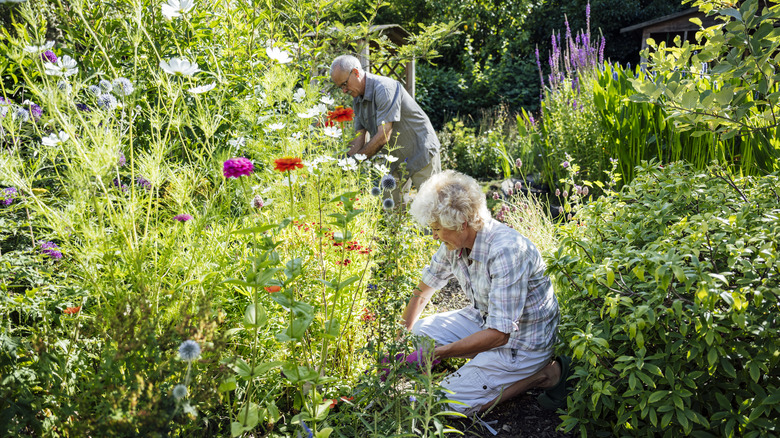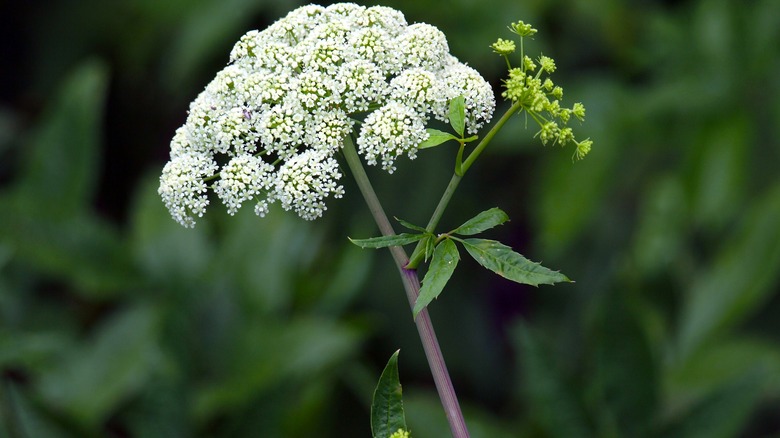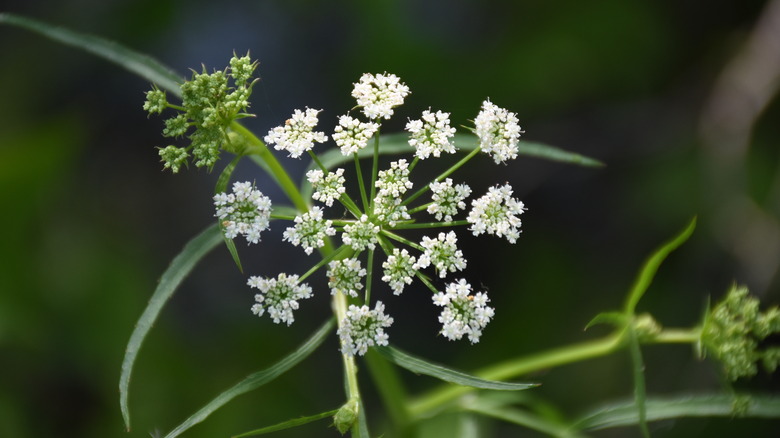The Most Dangerous Weed In The USA Could Be Growing In Your Backyard
When you spot new growth in your garden, it's always a cause for celebration ... well, almost always. Every plant lover wants to learn how to get rid of weeds in the garden, but this particular weed isn't your average nuisance. Water hemlock (Cicuta maculata), also known as spotted water hemlock, and Western water hemlock (Cicuta douglasii) are some of the most poisonous plants in North America, and unfortunately, one of them could be growing in your backyard. Not only are they toxic to humans and pets, but they can be fatal for livestock as well. Both varieties contain cicutoxin, which almost immediately reacts with humans' and animals' nervous systems. Its roots are the deadliest, though any part of the plant can be lethal. It doesn't take much either; even a small portion poses a fatal risk.
As members of the Apiaceae family, they can easily be confused with their nonpoisonous cousins like water parsnips or wild carrots. That said, all Cicuta species of plant are toxic. Flowers in the Cicuta genus are small and white, arranged in an umbrella-shaped pattern, known as an umbel. Unfortunately, other species within the carrot family have a similar look. The most distinctive trait of the water hemlock plant is the purple stripes on its stem, so keep an eye out for those. Their leaves are pinnately compound, meaning they have leaflets arranged on both sides of a common axis. If you're unsure, it's best to err on the side of caution.
Where does water hemlock grow?
As its name suggests, water hemlock plants commonly grow near wet areas like marshes, stream banks, slough margins, ditches, meadows, and wet pastures. Although western water hemlock is most common in British Columbia, its growth stretches from Alaska to California. However, water hemlock is native throughout North America. Not only are these plants toxic, but they're incredibly good at spreading. They reproduce in two ways: by their seeds and roots, which can survive all winter. Water or mud carries the seeds, especially if growing near irrigation canals, causing the plants to pop up in different locations. The seeds can root and grow into new plants even if they have been in the soil for up to three years.
Like other plants, it may find its way into your yard through other unique methods of transportation. When seeds get stuck on shoes, clothing, or machinery, they can travel to new locations, fall into the soil, and begin to grow. If one of these toxic plants sprouts up in your garden, it's vital you remove it carefully (more on that in the next section.) It's not just unsafe when ingesting; even getting water hemlock on your skin can be dangerous. According to a study published in the National Library of Medicine, the symptoms of poisoning include stomach pain, drooling nausea, vomiting, dizziness, heavy sweating, fatigue, and lethargy. They may progress into serious issues like trouble breathing, heart problems, convulsions, kidney failure, coma, and even death.
What to do if you find water hemlock in your yard
So, you've noticed one of these scary weeds in your yard. What are the next steps? To start, be incredibly careful not just when removing it from your garden, but also when disposing of it. First, make sure you're dressed appropriately in long sleeves and pants, closed-toed shoes, and waterproof gloves. If the ground is dry, you may need to water the area to loosen the soil, making it easier to get hold of the entire root. Pull up or dig out the entirety of any plants you find and place them into sealable bags. Double bag for extra precaution. Leave the bags outside in a sunny area where pets or livestock can't get to, so the water hemlock dries out and dies. Throw them away in the garbage; you should not add to your compost or brush pile.
After removal, monitor the area for regrowth, as a few stray seeds could have fallen into the soil. Occasionally checking the spot will allow you to eliminate new weeds that pop up more quickly. If there are any plants that haven't flowered, mowing will weaken the plant and prevent its spread. Again, wear proper attire before mowing and then clean the equipment, your clothes, and shoes once you're finished. You may also use herbicides in early spring. If you go the chemical route, contact your local weed control authority for recommendations, especially if treating an area near water.



